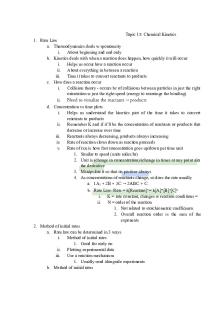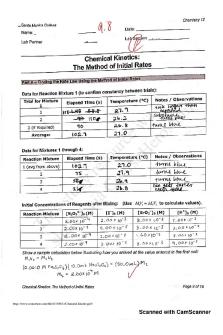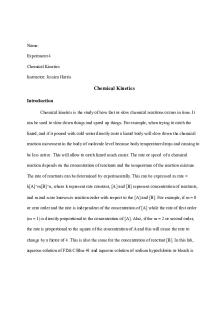Ch. 14 Chemical Kinetics Study Guide PDF

| Title | Ch. 14 Chemical Kinetics Study Guide |
|---|---|
| Author | Lynda Vann |
| Course | General Chemistry II |
| Institution | Miami Dade College |
| Pages | 11 |
| File Size | 192.3 KB |
| File Type | |
| Total Downloads | 39 |
| Total Views | 150 |
Summary
Another study guide for General Chemistry II (CHM1046) with questions much alike to exam questions your professor may give you!...
Description
CHM 1046 CHEMICAL KINETICS STUDY GUIDE Chapter 14 Brown & LeMay 13th Edition
Chapter 14: Chemical Kinetics
Competency 4: The student will demonstrate knowledge of chemical kinetics by: 1. Outlining the factors that affect the rate of a reaction (e.g., temperature, concentration, and catalysis). 2. Expressing the rate of a chemical reaction in terms of changes in concentration of reactants and products with time. 3. Applying the rate law-expression for a reaction to express the relationship between concentration and rate. 4. Applying the method of initial rates to find the rate-law expression for a reaction. 5. Determining the order of a reaction from the reaction rate law. 6. Using the integrated rate equation to determine the half-life of a reaction or to determine the concentration of substrate at some point in time. 7. Analyzing concentration versus time data to determine the order of a reaction. 8. Pointing out the fundamental notions of collision theory and transition state theory. 9. Describing the main aspects of transition state theory and the role of activation energy in determining the rate of a reaction. 10. Using the Arrhenius equation to relate the energy of activation for a reaction to changes in its rate constant with changing temperature.
Recommended Exercises Reaction Rates 14.17, 14.19, 14.21, 14.23, 14.25 Rate Laws 14.27, 14.29, 14.31, 14.33, 14.35 Change of Concentration with Time 14.39, 14.41, 14.43, 14.45, 14.49 Temperature and Rate 14.51, 14.61
1
Practice Problems 1. What are the units for the reaction rate? A. L mol–1 s–1 B. L2 mol–2 s–1 C. s–1 D. s–2 E. mol L–1 s–1 Answer: E 2. For the reaction BrO3 + 5Br+ 6H+ 3Br2 + 3H2O at a particular time, [BrO3]/t = 1.5 102 M/s. What is [Br]/t at the same instant? A. A. 13 M/s B. 7.5 102 M/s C. 1.5 102 M/s D. 3.0 103 M/s E. 330 M/s Answer: B 3. For the reaction A + 2B C, which expression is correct? A. [C]/t = [A]/t B. [C]/t = 2 [B]/t C. [C]/t = 2 [B]/t D. [C]/t = (1/2) [B]/t E. [C]/t = (1/2) [A]/t Answer: D 4. For the hypothetical reaction A + 3B 2C, the rate should be expressed as: A. rate = [A]/t B. rate = [C]/t C. rate = 3 ([B]/t) D. rate = (1/2) ([C]/t) E. rate = (1/3) ([B]/t) Answer: D
2
5. The reaction A + 2B products has the rate law, rate = k[A][B]3. If the concentration of B is doubled while that of A is unchanged, by what factor will the rate of reaction increase? A. 2 B. 4 C. 6 D. 8 E. 9 Answer: D 6. Consider the reaction 2NH3(g) → N2(g) + 3H2(g) If the rate Δ[H2]/Δt is 0.030 mol L-1 s-1, then Δ[NH3]/Δt is A. -0.045 mol L-1 s-1 B. -0.030 mol L-1 s-1 C. -0.020 mol L-1 s-1 D. -0.010 mol L-1 s-1 E. none of these choices is correct Answer: C 7. For the reaction 3A(g) + 2B(g) → 2C(g) + 2D(g) the following data was collected at constant temperature. Determine the correct rate law for this reaction. Trial Initial [A] Initial [B] Initial Rate (mol/L) (mol/L) (mol/(L·min)) 1 0.200 0.100 6.00 × 10-2 2 0.100 0.100 1.50 × 10-2 3 0.200 0.200 1.20 × 10-1 4 0.300 0.200 2.70 × 10-1 A. Rate = k[A][B] B. Rate = k[A][B]2 C. Rate = k[A]3[B]2 D. Rate = k[A]1.5[B] E. Rate = k[A]2[B] Answer: E
3
8. For the reaction A(g) + 2B(g) → 2C(g) + 2D(g) the following data was collected at constant temperature. Determine the correct rate law for this reaction. Trial Initial [A] Initial [B] Initial Rate (mol/L) (mol/L) (mol/(L·min)) 1 0.125 0.200 7.25 2 0.375 0.200 21.75 3 0.250 0.400 14.50 4 0.375 0.400 21.75 A. Rate = k[A] [B] B. Rate = k[A]2 [B] C. Rate = k[A] [B]2 D. Rate = k[A] E. Rate = k[A]3 Answer: D 9. For the reaction 2A + B + 2C → D + E the following initial rate data was collected at constant temperature. Determine the correct rate law for this reaction. All units are arbitrary. Trial [A] [B] [C] Rate 1 0.225 0.150 0.350 0.0217 2 0.320 0.150 0.350 0.0439 3 0.225 0.250 0.350 0.0362 4 0.225 0.150 0.600 0.01270 A. Rate = k [A][B][C] B. Rate = k [A]2[B][C] C. Rate = k [A]2[B][C]-1 D. Rate = k [A][B]2[C] -1 E. none of these choices is correct Answer: C
4
10. The rate constant for a reaction is 4.65 L mol-1s-1. What is the overall order of the reaction? A. zero B. first C. second D. third E. More information is needed to determine the overall order. Answer: C 11. Sulfuryl chloride, SO2Cl2(g), decomposes at high temperature to form SO2(g) and Cl2(g). The rate constant at a certain temperature is 4.68 × 10-5s-1. What is the order of the reaction? A. zero B. first C. second D. third E. More information is needed to determine the overall order. Answer: B 12. It takes 42.0 min for the concentration of a reactant in a first-order reaction to drop from 0.45 M to 0.32 M at 25C. How long will it take for the reaction to be 90% complete? A. 13.0 min B. 86.0 min C. 137 min D. 222 min E. 284 min Answer: E 13. Which is the following is the correct unit for a 0th-order rate constant? A. s-1 B. Ms-1 C. Ms D. M-1s-1 E. M-2s-1 Answer: B
5
14. The data below were determined for the reaction, S2O82 + 3I (aq) 2SO42 + I3. Expt. # [S2O82] [I ] Initial Rate 1 0.038 0.060 1.4 10 – 5 M/s 2 0.076 0.060 2.8 10 – 5 M/s 3 0.076 0.030 1.4 10 – 5 M/s The rate law for this reaction must be: A. rate = k[S2O82 ][I ]3 B. rate = k[S2O82] C. rate = k[S2O82]2[I ]2 D. rate = k[I ] E. rate = k[S2O82][I ] Answer: E 15. A certain first-order reaction A B is 25% complete in 42 min at 25C. What is the half-life of the reaction? A. 21 min B. 42 min C. 84 min D. 120 min E. 101 min Answer: E 16. A first-order reaction has a rate constant of 3.00 103 s1. The time required for the reaction to be 75.0% complete is? A. 95.8 s B. 462 s C. 231 s D. 201 s E. 41.7 s Answer: B 17. A certain first-order reaction A B is 25% complete in 42 min at 25C. What is its rate constant? A. 6.8 103 min1 B. 8.3 103 min1 C. 3.3 102 min1 D. d)3.3 102 min1 E. 11 min1 Answer: A 6
18. The first-order reaction SO2Cl2 SO2 + Cl2 is 10% complete in 80. min. How long would it take for the reaction to be 95% complete? A. 1.8 min B. 104 min C. 530 min D. 2300 min E. 990 min Answer: D 19. When the reaction A → B + C is studied, a plot 1/[A]t vs. time gives a straight line with a positive slope. What is the order of the reaction? A. zero B. first C. second D. third E. More information is needed to determine the order. Answer: C 20. Nitric oxide gas (NO) reacts with chlorine gas according to the equation, NO + ½Cl2 NOCl. The following initial rates of reaction have been measured for the given reagent concentrations. Expt. # Rate (M/hr) NO (M) Cl2 (M) 1 1.19 0.50 0.50 2 4.79 1.00 0.50 3 9.59 1.00 1.00 Which of the following is the rate law (rate equation) for this reaction? a) rate = k[NO] b) rate = k[NO][Cl2]1/2 c) rate = k[NO][Cl2] d) rate = k[NO]2[Cl2] e) rate = k[NO]2[Cl2]2 Answer: D
7
21. Tetrafluoroethylene, C 2F4, can be converted to octafluorocyclobutane which can be used as a refrigerant or an aerosol propellant. A plot of 1/[C2F4] vs. time gives a straight line with a slope of 0.0448 L mol-1s-1. What is the rate law for this reaction? A. Rate = 0.0448 (L mol-1s-1)[C2F4] B. Rate = 22.3 (mol L-1s)[C2F4] C. Rate = 0.0448 (L mol-1s-1)[C2F4]2 D. Rate = 22.3 (mol L-1s)[C2F4]2 E. Rate = 0.0448 s-1 [C2F4] Answer: C 22. Cyclopropane is converted to propene in a first-order process. The rate constant is 5.4 × 10-2 hr-1. If the initial concentration of cyclopropane is 0.150 M, what will its concentration be after 22.0 hours? A. 0.0457 M B. 0.105 M C. 0.127 M D. 0.492 M E. none of these choices is correct Answer: A 23. The rate law for the reaction 3A → 2B is rate = k[A] with a rate constant of 0.0447 hr-1. What is the half-life of the reaction? A. 0.0224 hr B. 0.0645 hr C. 15.5 hr D. 22.4 hr E. 44.7 hr Answer: C 24. The rate law for the rearrangement of CH3NC to CH3CN at 800 K is rate = (1300 s-1)[CH3NC]. What is the half-life for this reaction? A. 7.69 × 10-4 s B. 5.3 × 10-4 s C. 1.9 × 10-3 s D. 520 s E. 1920 s Answer: B
8
25. Butadiene, C4H6 (used to make synthetic rubber and latex paints) dimerizes to C8H12 with a rate law of rate = 0.014 L/(mol·s) [C4H6]2. What will be the concentration of C4H6 after 3.0 hours if the initial concentration is 0.025 M? A. 0.0052 M B. 0.024 M C. 43 M D. 190 M E. 0.0000 M Answer: A 26.
The rate law for the reaction 3A → C is: Rate = 4.36 × 10-2 L mol-1 hr-1[A]2 What is the half-life for the reaction if the initial concentration of A is 0.250 M? A. 0.0109 hr B. 0.0629 hr C. 15.9 hr D. 23.9 hr E. 91.7 hr Answer: E
27. The isomerization of cyclopropane follows first order kinetics. The rate constant at 700 K is 6.20 104 min1, and the half-life at 760 K is 29.0 min. Calculate the activation energy for this reaction (R = 8.314 J/mol K). A. 5.07 kJ/mol B. 27.0 kJ/mol C. 50.7 kJ/mol D. 160. kJ/mol E. 270. kJ/mol Answer: E
9
28. The isomerization of methyl isocyanide, CH3NC CH3CN, follows firstorder kinetics. The half-lives were found to be 161 min at 199C and 12.5 min at 230C. Calculate the activation energy for this reaction (R = 8.314 J/mol K). A. 6.17 103 kJ/mol B. 31.4 kJ/mol C. 78.2 kJ/mol D. 124 kJ/mol E. 163 kJ/mol Answer: E 29. The activation energy for the following first-order reaction is 102 kJ/mol. N2O5(g) 2NO2(g) + (1/2)O2(g) The value of the rate constant (k) is 1.35 104 s1 at 35C. What is the value of k at 0C (R = 8.314 J/mol K)? A. 8.2 107 s1 B. 1.9 105 s1 C. 4.2 105 s1 D. 2.2 102 s1 E. none of these Answer: A 30. A rate constant obeys the Arrhenius equation, the factor A being 2.2 × 1013 s-1 and the activation energy being 150. kJ mol-1. What is the value of the rate constant at 227°C, in s-1 (R = 8.314 J/mol K)? A. 2.1 × 1013 s-1 B. 6.7 × 10-22 s-1 C. 1.5 × 1011 s-1 D. 4.7 × 10-3 s-1 E. none of these choices is correct Answer: D
10...
Similar Free PDFs

Ch. 14 Chemical Kinetics Study Guide
- 11 Pages

Chapter 14- Chemical Kinetics
- 3 Pages

Topic 15 Chemical Kinetics
- 5 Pages

Chemical Kinetics lab
- 9 Pages

Chemical Kinetics-DR. ASM
- 44 Pages

Chemical Kinetics - lab report
- 4 Pages

Lab 11 Chemical Kinetics Report
- 4 Pages

Chapter 14 - Kinetics
- 6 Pages

Chemical Kinetics - Lecture notes 1
- 23 Pages

Chapter 14 study guide
- 7 Pages

Chapter 14 - Study Guide
- 19 Pages

Note 14 - study guide
- 4 Pages

Chapter 14 study guide
- 1 Pages

Study Guide Chapter 14
- 2 Pages
Popular Institutions
- Tinajero National High School - Annex
- Politeknik Caltex Riau
- Yokohama City University
- SGT University
- University of Al-Qadisiyah
- Divine Word College of Vigan
- Techniek College Rotterdam
- Universidade de Santiago
- Universiti Teknologi MARA Cawangan Johor Kampus Pasir Gudang
- Poltekkes Kemenkes Yogyakarta
- Baguio City National High School
- Colegio san marcos
- preparatoria uno
- Centro de Bachillerato Tecnológico Industrial y de Servicios No. 107
- Dalian Maritime University
- Quang Trung Secondary School
- Colegio Tecnológico en Informática
- Corporación Regional de Educación Superior
- Grupo CEDVA
- Dar Al Uloom University
- Centro de Estudios Preuniversitarios de la Universidad Nacional de Ingeniería
- 上智大学
- Aakash International School, Nuna Majara
- San Felipe Neri Catholic School
- Kang Chiao International School - New Taipei City
- Misamis Occidental National High School
- Institución Educativa Escuela Normal Juan Ladrilleros
- Kolehiyo ng Pantukan
- Batanes State College
- Instituto Continental
- Sekolah Menengah Kejuruan Kesehatan Kaltara (Tarakan)
- Colegio de La Inmaculada Concepcion - Cebu

